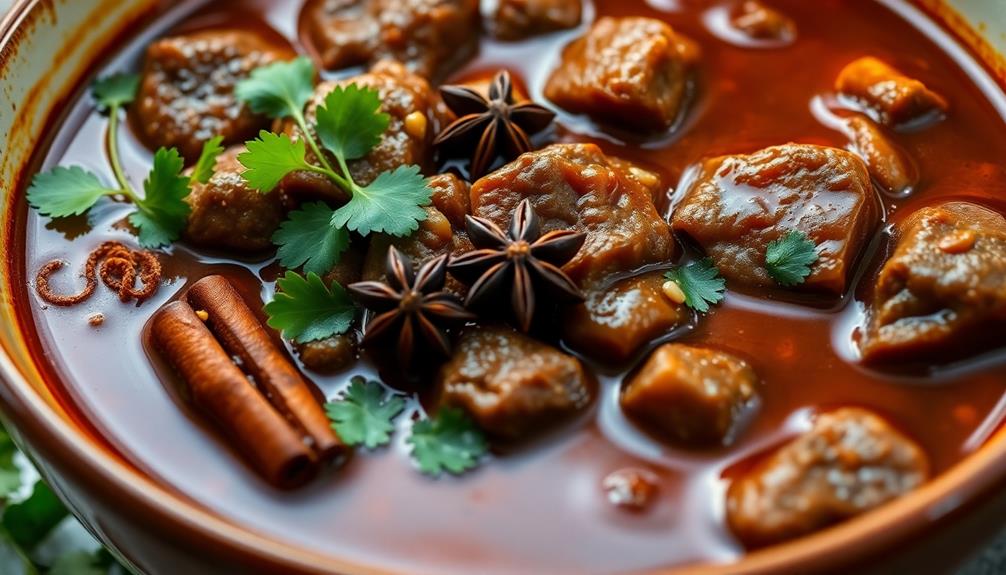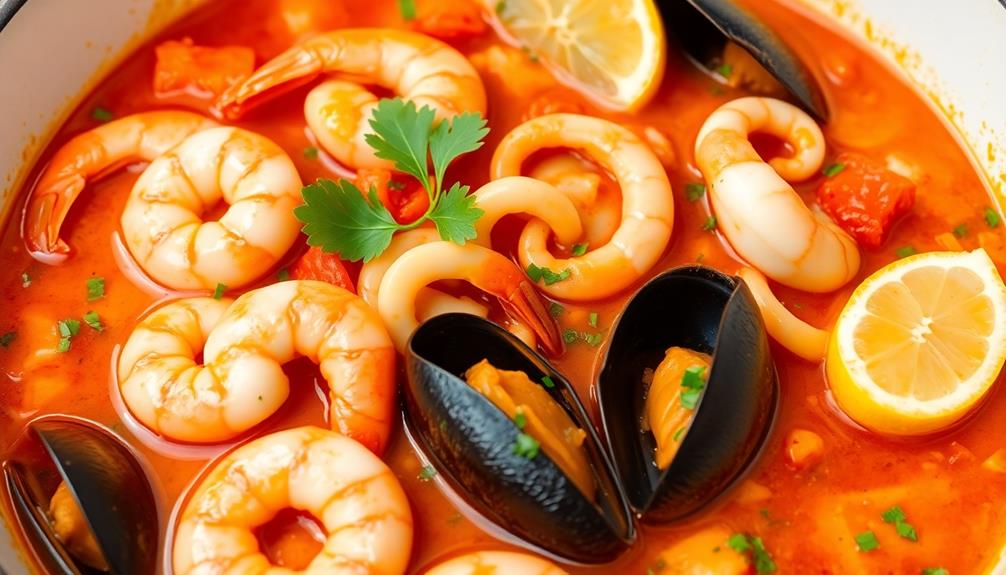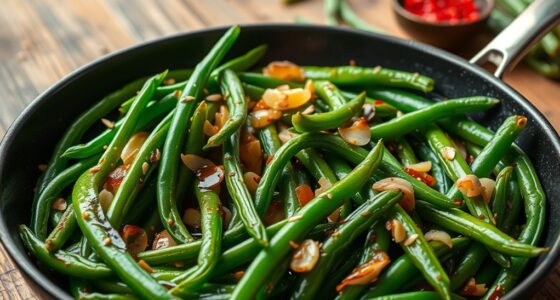Beef semur is a beloved Indonesian beef stew that'll transport your taste buds straight to the heart of Javanese cuisine! This dish evolved from the fragrant curries of the Indonesian archipelago, with its name derived from the Javanese word "seme" meaning "to simmer." Tender beef, aromatic spices, and a savory sauce come together in perfect harmony, creating a depth of flavor that'll warm your soul. Typically served with steamy white rice, beef semur is a staple in Indonesian homes and restaurants, offering a comforting experience. If you're craving an authentic Indonesian dish that'll leave a lasting impression, get ready to discover the delights of beef semur!
Key Takeaways
- Beef Semur is an authentic Indonesian beef stew originating from Javanese cuisine, featuring tender beef simmered in a rich, aromatic broth.
- The dish is characterized by a harmonious blend of spices, including garlic, shallots, ginger, lemongrass, lime leaves, cinnamon, and star anise.
- Coconut milk and beef broth are used to create a savory, slightly tangy, and sweet flavor profile, further enhanced by the addition of potatoes.
- Crispy fried shallots are typically used as a garnish, adding a delightful crunchy texture and savory taste to the dish.
- Beef Semur is a staple in Indonesian homes and restaurants, known for its comforting qualities and long-term appeal as a beloved culinary classic.
History
The origins of Beef Semur can be traced back to the Javanese cuisine of Indonesia. This hearty stew has been a beloved dish for centuries, passed down through generations.
It's believed to have evolved from the rich, fragrant curries that were popular across the Indonesian archipelago. Over time, the recipe was adapted to feature beef as the primary protein, creating a unique and satisfying dish.
Semur is thought to be derived from the Javanese word "seme" meaning "to simmer." This cooking method allows the flavors to meld together, resulting in a deep, complex taste.
The dish typically includes tender beef, aromatic spices, and a savory sauce that's simmered until the meat is fall-off-the-bone tender.
Beef Semur has become a staple in Indonesian homes and restaurants, enjoyed for its comforting and satisfying qualities.
Recipe
Beef Semur is a rich, flavorful Indonesian beef stew that's commonly enjoyed with steamed rice. The dish features tender beef chunks simmered in a savory sauce, infused with aromatic spices and coconut milk. This comforting one-pot meal is sure to warm the soul and delight the senses. Additionally, incorporating ingredients like high levels of antioxidants can enhance the nutritional profile of your meal. For a more authentic flavor, you can also add a few pieces of Indonesian bay leaves and kaffir lime leaves to the stew. These traditional ingredients are commonly used in the traditional recipe for beef rendang, another popular Indonesian beef dish. By incorporating these elements, you can elevate the depth of flavors in your Beef Semur and create a truly memorable dining experience. Whether you’re a fan of Indonesian cuisine or simply love hearty stews, Beef Semur is a dish that’s sure to become a favorite in your recipe repertoire.
Originating from the Javanese cuisine, Beef Semur is a beloved staple that has gained popularity throughout Indonesia and beyond. The depth of flavor in this dish comes from the harmonious blend of spices, including garlic, shallots, ginger, and a hint of cinnamon, which together create a complex and aromatic base.
- 1 lb beef chuck, cut into 1-inch cubes
- 2 cups coconut milk
- 2 cups beef broth
- 4 cloves garlic, minced
- 2 shallots, thinly sliced
- 2 inches ginger, peeled and grated
- 2 lemongrass stalks, bruised
- 2 kaffir lime leaves
- 1 cinnamon stick
- 2 star anise
- 2 tablespoons soy sauce
- 1 tablespoon brown sugar
- Salt and pepper to taste
- Garnish: Fried shallots, green onions, and lime wedges
In a large pot or Dutch oven, sear the beef over high heat until browned on all sides, about 5 minutes. Remove the beef from the pot and set aside.
Reduce the heat to medium, and in the same pot, sauté the garlic, shallots, and ginger until fragrant, about 2 minutes. Add the lemongrass, lime leaves, cinnamon stick, and star anise, and cook for an additional minute.
Pour in the coconut milk and beef broth, and bring the mixture to a simmer. Return the seared beef to the pot, cover, and let the stew simmer for 1 to 1.5 hours, or until the beef is tender and the flavors have melded.
To enhance the depth of flavor, consider marinating the beef in a mixture of soy sauce, brown sugar, and spices for 30 minutes to an hour before cooking. This will help the meat absorb more of the delicious seasonings.
Serve Beef Semur hot, accompanied by steamed rice, fried shallots, green onions, and a squeeze of fresh lime juice for a truly authentic and satisfying Indonesian dining experience.
Cooking Steps
First, sear that beef until it's nice and browned.
Then, add in the aromatic ingredients and let them work their magic.
Step 1. Sear Beef Until Browned

Grab your trusty skillet and crank up the heat to high. It's time to sear that beefy goodness until it's beautifully browned.
Start by patting the beef cubes dry with paper towels. This will help them get that delicious caramelized crust we're after.
Once your skillet is ripping hot, add a drizzle of oil. Toss in the beef, making sure not to overcrowd the pan. You want the pieces to have plenty of room to sizzle and brown. For added flavor, consider using essential oils like peppermint oil for a refreshing aroma while cooking.
Now, here's the key – don't touch those cubes! Let them sear undisturbed for 2-3 minutes. The beef will naturally release from the pan when it's ready to flip. Resist the urge to poke and prod.
Flip the pieces and let the other side get that same dark, crispy goodness. After about 5 minutes total, your beef should be beautifully browned all over.
Transfer it to a plate and get ready for the next step in this flavor-packed Beef Semur adventure!
Step 2. Add Aromatics
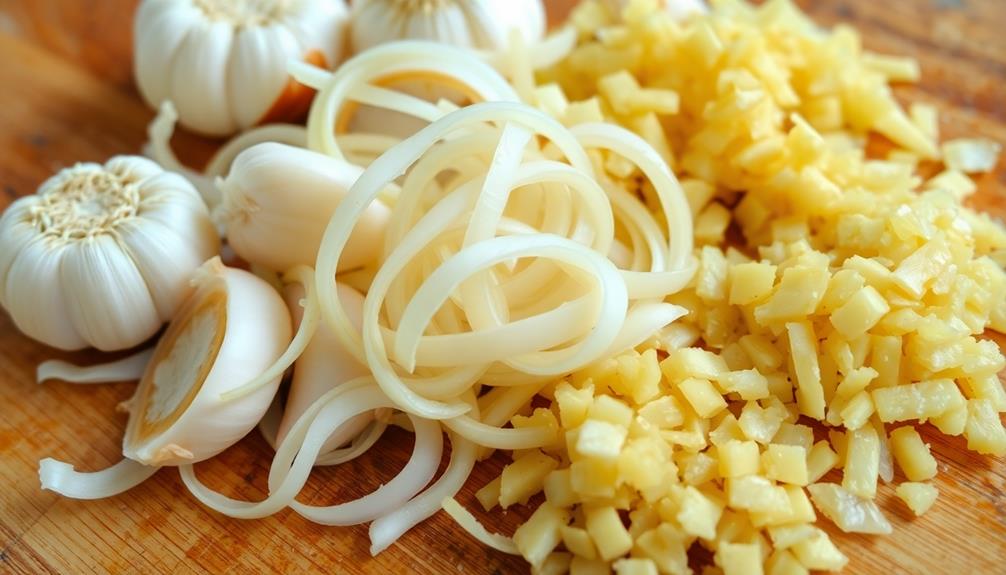
With the beef seared to perfection, let's move on to building layers of flavor. Next, you'll add the aromatics – those fragrant ingredients that will infuse your stew with incredible aroma and taste.
Start by chopping up some garlic and shallots. The garlic will add a warm, savory note, while the shallots will contribute a slightly sweet, oniony flavor. Toss these into the pot along with fresh ginger, which will bring a lovely zing to the dish.
Aromatics like these can also play a role in enhancing emotional well-being, as certain scents have been shown to promote relaxation and reduce stress levels, making your cooking experience even more enjoyable the benefits of aromatherapy.
Now, it's time to toast some spices. Grab a handful of whole cloves, cinnamon sticks, and star anise. These will release their aromatic oils as they gently toast in the pan, filling your kitchen with the most enticing scents.
Stir them around until you can really smell their fragrance – that's when you'll know they're ready. With the aromatics sizzling and the spices toasted, your stew is well on its way to becoming an absolute flavor sensation.
Step 3. Add Coconut Milk and Simmer

Next, pour in the coconut milk and let the stew gently simmer. The rich, creamy coconut milk will mingle with the bold flavors, creating a wonderfully aromatic and savory broth.
As it simmers, the beef will become even more tender, practically falling apart with the slightest nudge of your spoon.
Adjust the heat to maintain a gentle bubble, and let the stew simmer for about 30 minutes. This allows the flavors to meld and the beef to fully tenderize.
Stir occasionally, making sure nothing sticks to the bottom of the pot.
The coconut milk will add a lovely, velvety texture to the stew. It balances the bold spices and infuses the dish with a subtle sweetness.
Breathe in the captivating aroma as the stew simmers – it's sure to have your mouth watering in anticipation.
Once the time is up, your Beef Semur is ready to serve over steaming white rice. Get ready for an authentic taste of Indonesian cuisine!
Step 4. Add Potatoes and Simmer
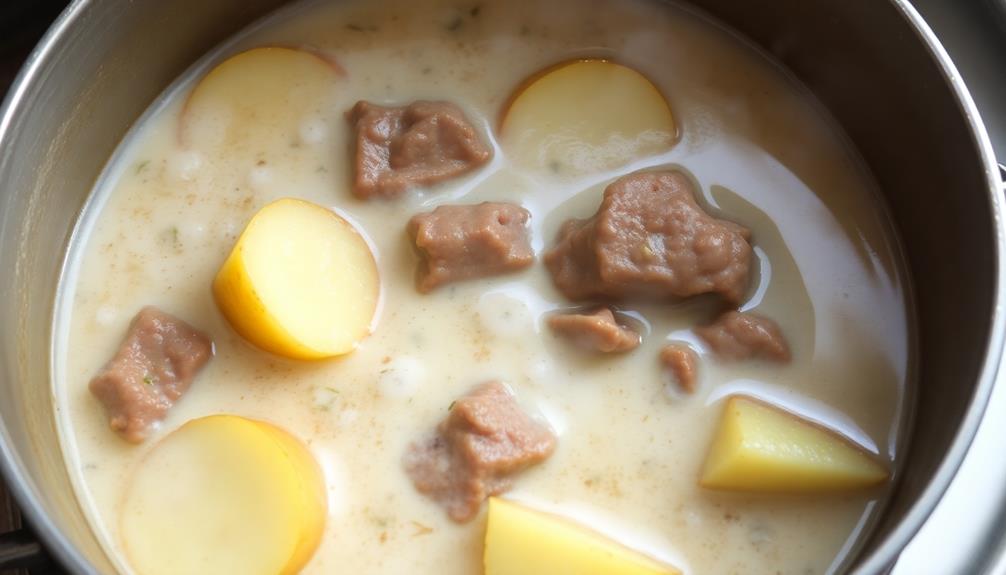
After letting the flavors meld in the coconut milk, it's time to add the potatoes and continue simmering.
Grab your potatoes and chop them into bite-sized chunks. Carefully slide the potatoes into the simmering sauce, making sure they're fully submerged. Let the dish continue to simmer for another 20-25 minutes, stirring occasionally, until the potatoes are tender when pierced with a fork.
As the potatoes cook, they'll soak up all the rich, aromatic flavors of the beef and spices. The stew will thicken up nicely, creating a hearty, comforting texture.
Keep an eye on the pot, adding a splash of water if it starts to look too thick. You want a nice, saucy consistency that'll be perfect for spooning over steamed rice.
Once the potatoes are tender, your beef semur is ready to serve!
Get ready to enjoy the mouthwatering combination of tender beef, creamy coconut, and fluffy potatoes in every bite.
Step 5. Garnish With Crispy Fried Shallots

To finish off your beef semur, you'll want to add a crispy and flavorful garnish. Crispy fried shallots are the perfect topping, adding a delightful crunch and rich, caramelized flavor.
Start by thinly slicing a few shallots. Heat a small amount of oil in a skillet over medium heat. Once the oil is hot, carefully add the shallot slices and fry for a minute or two, stirring frequently, until they turn golden brown and crispy. Be careful not to let them burn.
Remove the crispy shallots from the oil using a slotted spoon and drain them on a paper towel-lined plate. Season with a pinch of salt while they're still hot. The shallots should be delightfully crispy and intensely flavorful.
Sprinkle the crispy fried shallots generously over the top of your beef semur just before serving. Their crunchy texture and savory taste will take your stew to the next level. Enjoy!
Final Thoughts
With the semur beef dish now complete, you can sit back and savor the rich, flavorful result of your culinary efforts. The combination of tender beef, aromatic spices, and the slightly tangy, sweet sauce is truly a delight for the senses.
As you take that first bite, you'll be impressed by how the flavors meld together seamlessly, creating a harmonious and satisfying meal. One of the best things about this dish is its versatility. Whether you're serving it as a main course or as part of a larger spread, it's sure to be a crowd-pleaser.
The crispy fried shallots you added as a garnish provide a wonderful textural contrast, adding a delightful crunch to each bite. This touch of extra flavor and crispiness really elevates the dish, making it truly exceptional.
As you savor the last few bites, you'll find yourself already planning when you can make this delicious beef semur again. It's a recipe that's sure to become a staple in your culinary repertoire, bringing the flavors of Indonesia right to your table.
Frequently Asked Questions
What Is the Ideal Beef Cut for Beef Semur?
You'll want to use a tougher, more flavorful beef cut for this dish. Chuck or shoulder cuts are ideal as they'll become tender and absorb the aromatic spices during the long simmering process.
Can Beef Semur Be Made in a Slow Cooker?
Absolutely, you can make beef stew in a slow cooker. The slow, gentle heat will tenderize even tougher cuts of meat, making it an ideal cooking method. Just add your ingredients and let the slow cooker do the work.
How Long Does Beef Semur Last in the Refrigerator?
Beef stew can last 3-4 days in the refrigerator when stored properly. You'll want to keep it in an airtight container and make sure it's cooled completely before refrigerating. This will help it maintain its flavor and texture.
Can Beef Semur Be Frozen for Later Use?
Yes, you can freeze beef semur for later use. It'll keep for up to 3 months in the freezer. Just make sure to store it in an airtight container or freezer bag to prevent freezer burn.
What Are Some Popular Side Dishes to Serve With Beef Semur?
When serving this hearty dish, you'll find that it pairs beautifully with steamed rice, mashed potatoes, or a fresh salad. The savory flavors of the stew complement these classic side options perfectly.
